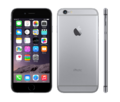More actions
| IPhone 6 | |
|---|---|
| Manufacturer | Apple |
| Code name | A1549, A1586, A1589 |
| Release date | 2014-09-19 |
| Device type | Phone |
This article is a stub. You can help Repair Wiki grow by expanding it
Guides
Explanatory Guides
| Type | Difficulty | |
|---|---|---|
| Parts that are serialized on iPhones | Troubleshooting/Diagnostics |
Repair Guides
| Affects part | Type | Difficulty | |
|---|---|---|---|
| How To Recover Original Sysconfig Data from iPhone | Main Logic Board NAND | Soldering | 4. Specialist |
| IPhone 6 No Service Modem Firmware OK | Motherboard | Soldering | 3. Hard |
| IPhone 6 boots to Apple logo and turns back off fix | Software | Software | 1. Easy |
Create a Guide
Device pictures
PCB pictures
Reference measurements (also schematics if available)
-
Diode mode for iPhone 6 Display connector. Top Right goes to top edge of the board, under the rear camera.
-
iPhone 6 Touch connector. Top right goes to top edge of the board.
-
iPhone 6 battery connector. Bottom left goes to the edge of the board, next to the bottom of the battery.
-
iPhone 6 charge port / dockflex connector diode mode readings. Bottom right goes to bottom of the phone, where the loudspeaker is.
-
iPhone 6 home button / TouchID connector. Top right goes to the top of the board, under the rear camera.
-
iPhone 6 rear camera connector. Top right goes to the top of the board, under the rear camera.
-
iPhone 6 front flex connector. Contains front camera, proximity sensor, ambient light sensor, earspeaker. Top right goes to top of the board, under the rear camera.
-
iPhone 6 Volume, power buttons, ringer switch and flaslight connector. Top left goes to top edge of the board, next to the mute/ringer switch.
More Information/External Sources
You can manually link to external sources for additional information that might not fit here but are useful such as BIOS image dumps, firmware, etc!
iPhone 6 Schematics: https://www.sendspace.com/file/5k4rim





